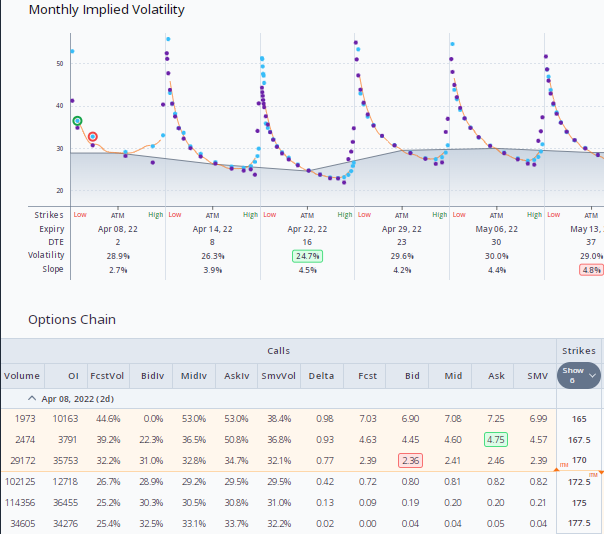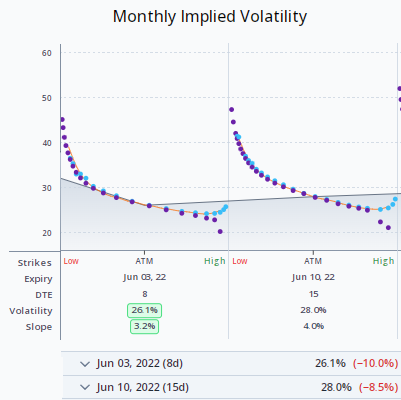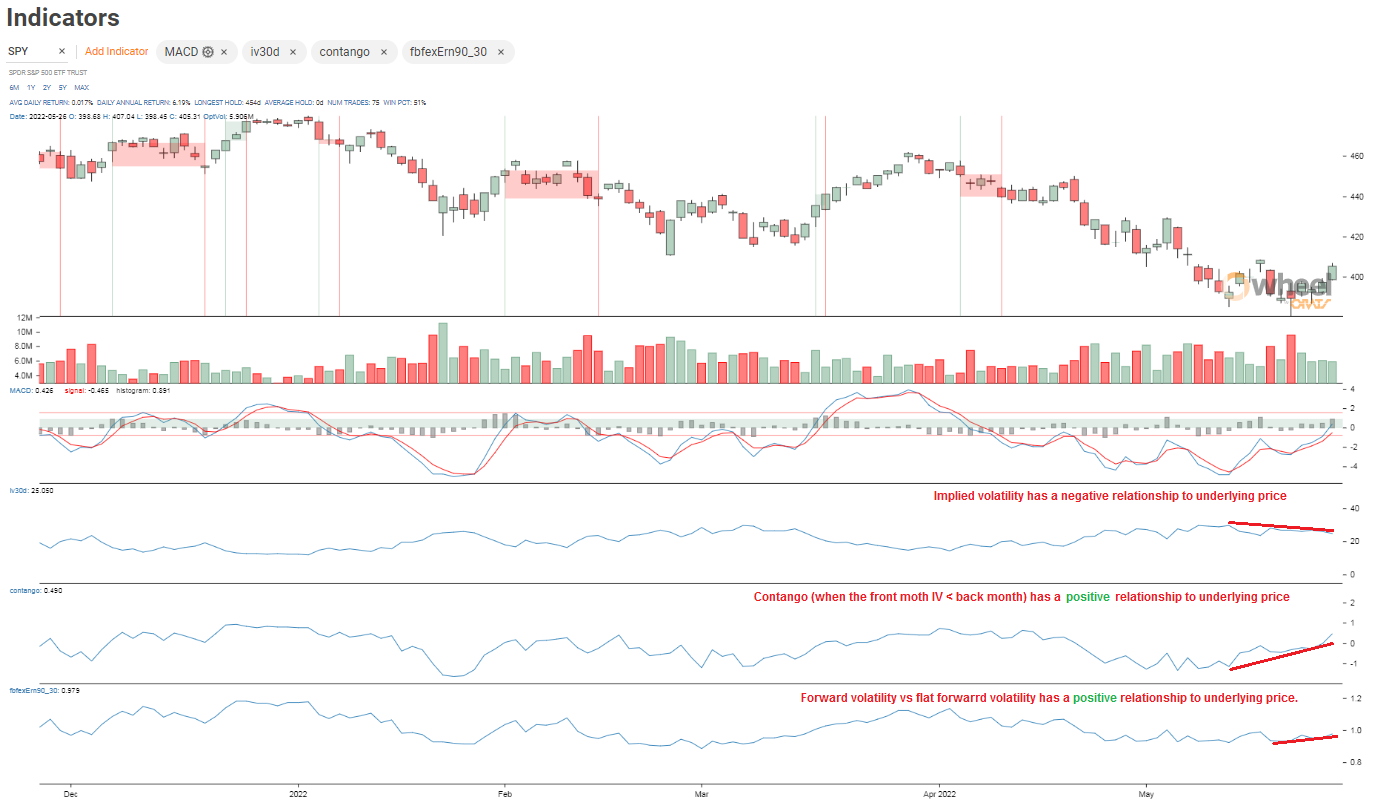Indicators
Thursday, April 7th 2022
Options 101: Chain Data Definitions
Defining the basics of the typical options chain: Strike, expiry, implied volatility and more.
Summary
This document provides an overview of the fields in an options chain, including ticker, trade date, expiration date, days to expiration, strike, stock price, call and put volumes, open interest, bid and ask sizes and prices, implied volatilities, greeks, and more. The options chain contains the raw materials for options trading, and options prices are displayed with their associated information. This article provides detailed explanations of each field in the ORATS options chain.
Options chains contain the informational raw materials for options trading. Options prices are displayed with their associated implied volatilities, greeks and standard options information like strike, expiry and call or put.
Below we list out the fields in the ORATS options chain and explanations for each.
- ticker: At the initial public offering, a company selects an available symbol that is sometimes related to the spelling or meaning of the firm. NYSE tickers are usually three or fewer letters where Nasdaq ones have four or more.
- tradeDate: The trade date is the date when the observation of options prices are made.
- expirDate: Options have expiration dates in the future when the contract between buyer and seller terminate. If the option finishes in the money, with the stock price above the strike price for a call or below or a put, the option seller is expected to deliver the shares to the buyer.
- dte: The days to expiration is the expiration date minus the trade date plus 1 day. The one day is there to provide a value for the option because with zero days left there is no value.
- strike: The option strike is the price to compare to the stock price in an options contract. If the stock price is above the strike price for a call or below or a put, the option seller is expected to deliver the shares to the buyer.
- stockPrice: The stock price of the underlying security in the options contract is important to compare to the strike price at expiration.
- callVolume: The call option volume is the total traded volume for the day of the calls with the expiration and strike stated in the row.
- callOpenInterest: The call open interest is updated nightly by the Options Clearing Corporation (OCC) and show the total number of opening contracts versus closing contracts by market participants.
- callBidSize: The publicly displayed call bid size by market participants of the amount they are willing to buy at this price.
- callAskSize: The publicly displayed call ask size by market participants of the amount they are willing to sell at this price.
- putVolume: The put option volume is the total traded volume for the day of the puts with the expiration and strike stated in the row.
- putOpenInterest: The put open interest is updated nightly by the Options Clearing Corporation (OCC) and show the total number of opening contracts versus closing contracts by market participants.
- putBidSize: The publicly displayed put bid size by market participants of the amount they are willing to buy at this price.
- putAskSize: The publicly displayed put ask size by market participants of the amount they are willing to sell at this price.
- callBidPrice: The value from an options pricing model using the inputs for the call option and the volatility from a smoothing of the implied volatilities for the options within the expiration.
- callValue: The value from an options pricing model using the inputs for the call option and the volatility from a smoothing of the implied volatilities for the options within the expiration.
- callAskPrice: The publicly displayed best call ask price by market participants to sell this call.
- putBidPrice: The publicly displayed best put bid price by market participants to buy this put.
- putValue: The value from an options pricing model using the inputs for the put option and the volatility from a smoothing of the implied volatilities for the options within the expiration.
- putAskPrice: The publicly displayed best put ask price by market participants to sell this put.
- callBidIv: The volatility input from an options pricing model using the inputs for the call option and solving for a volatility until the price from the formula matches the bid price of the call.
- callMidIv: The volatility input from an options pricing model using the inputs for the call option and solving for a volatility until the price from the formula matches the mid price of the bid and ask of the call.
- callAskIv: The volatility input from an options pricing model using the inputs for the call option and solving for a volatility until the price from the formula matches the ask price of the call.
- smvVol: The volatility found from a smoothing of the implied volatilities for the options within the expiration.
- putBidIv: The volatility input from an options pricing model using the inputs for the put option and solving for a volatility until the price from the formula matches the bid price of the put.
- putMidIv: The volatility input from an options pricing model using the inputs for the put option and solving for a volatility until the price from the formula matches the mid price of the bid and ask price of the put.
- putAskIv: The volatility input from an options pricing model using the inputs for the put option and solving for a volatility until the price from the formula matches the ask price of the put.
- residualRate: The interest rated found from solving for the put and call values in an options pricing model that matches the put and call values in the market.
- delta: The delta is the expected change in the price of the option with a one dollar change in the underlying.
- gamma: The gamma is the expected change in the delta of the option with a one dollar change in the underlying.
- theta: The theta is the expected change in the price of the option with a one day change.
- vega: The vega is the expected change in the price of the option with a one point change in the volatility.
- rho: The rho is the expected change in the price of the option with a one percent change in the interest rate.
- phi: The phi is the expected change in the price of the option with a one percent change in the dividend rate.
- driftlessTheta: The driftless theta is the expected change in the price of the option with a one day change without taking in drift in underlying.
- forecastVol: A forecast of volatility is made using the historical volatility of the underlying instrument.
- fcstCallValue: The value from an options pricing model using the inputs for the call option and the forecast volatility.
- fcstPutValue: The value from an options pricing model using the inputs for the put option and the forecast volatility.
- spotPrice: The spot price of an index is the calculated value given the constituents prices and weightings to the index.
- updatedAt: date and time of data updated
Below is an options chain graph and table for AAPL calls.

Disclaimer:
The opinions and ideas presented herein are for informational and educational purposes only and should not be construed to represent trading or investment advice tailored to your investment objectives. You should not rely solely on any content herein and we strongly encourage you to discuss any trades or investments with your broker or investment adviser, prior to execution. None of the information contained herein constitutes a recommendation that any particular security, portfolio, transaction, or investment strategy is suitable for any specific person. Option trading and investing involves risk and is not suitable for all investors.
All opinions are based upon information and systems considered reliable, but we do not warrant the completeness or accuracy, and such information should not be relied upon as such. We are under no obligation to update or correct any information herein. All statements and opinions are subject to change without notice.
Past performance is not indicative of future results. We do not, will not and cannot guarantee any specific outcome or profit. All traders and investors must be aware of the real risk of loss in following any strategy or investment discussed herein.
Owners, employees, directors, shareholders, officers, agents or representatives of ORATS may have interests or positions in securities of any company profiled herein. Specifically, such individuals or entities may buy or sell positions, and may or may not follow the information provided herein. Some or all of the positions may have been acquired prior to the publication of such information, and such positions may increase or decrease at any time. Any opinions expressed and/or information are statements of judgment as of the date of publication only.
Day trading, short term trading, options trading, and futures trading are extremely risky undertakings. They generally are not appropriate for someone with limited capital, little or no trading experience, and/ or a low tolerance for risk. Never execute a trade unless you can afford to and are prepared to lose your entire investment. In addition, certain trades may result in a loss greater than your entire investment. Always perform your own due diligence and, as appropriate, make informed decisions with the help of a licensed financial professional.
Commissions, fees and other costs associated with investing or trading may vary from broker to broker. All investors and traders are advised to speak with their stock broker or investment adviser about these costs. Be aware that certain trades that may be profitable for some may not be profitable for others, after taking into account these costs. In certain markets, investors and traders may not always be able to buy or sell a position at the price discussed, and consequently not be able to take advantage of certain trades discussed herein.
Be sure to read the OCCs Characteristics and Risks of Standardized Options to learn more about options trading.
Related Posts



